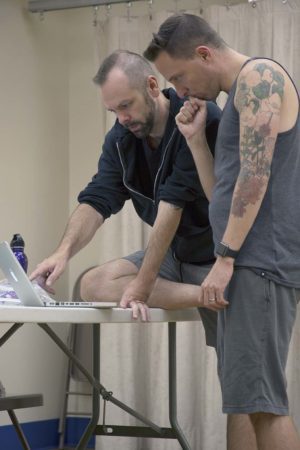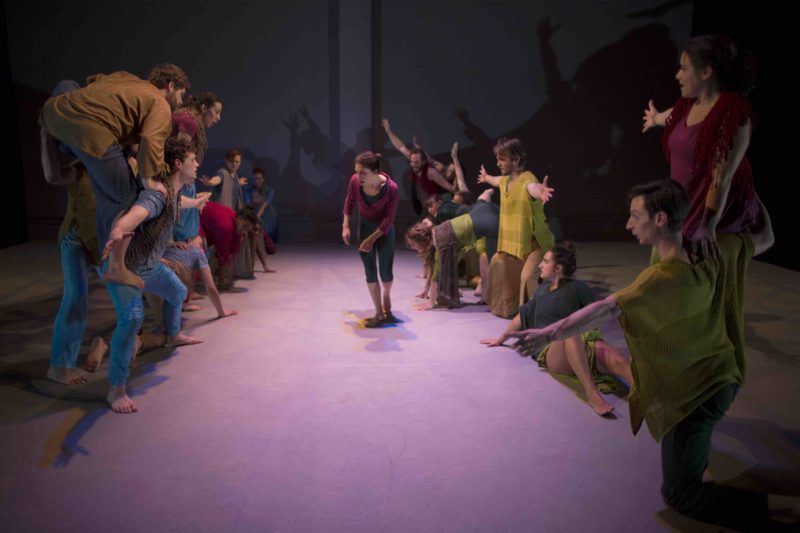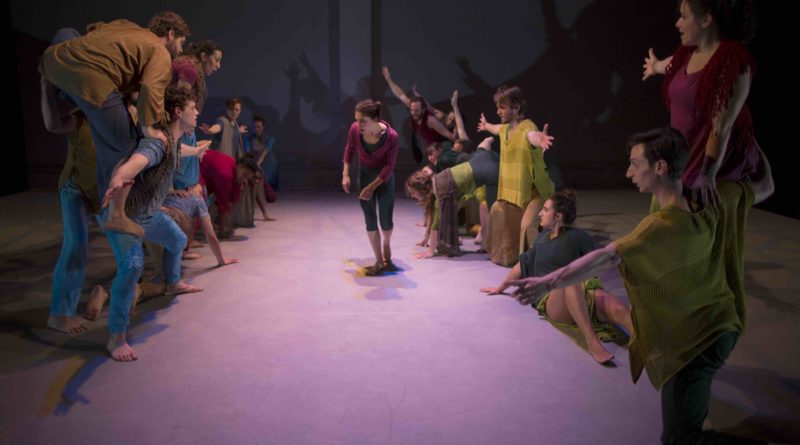INTERVIEW: 24 dancers build tower of ‘BABEL’ in new acrobatic dance show

Taking in a performance of BABEL will surely be a towering experience. The show, which features acrobatics, dance and theater, is the brainchild of co-creators WT McRae and Jeremy Williams, and plays The Theater at the 14th Street Y in New York City through Feb. 5.
A troupe of 24 dancers build the infamous tower of Babel in the movement piece, all the while exploring themes of ambition and grief. The classic story is given a new interpretive flair, but the basics are all accounted for: The tower is built so high that it offends the gods, and when the dancers are struck down to their earthly lows, they find themselves divided and yearning for the unity of their human sculpture.
Music for the Convergences Theatre Collective production was composed by Julie Zhu and Robert Fleitz. Costumes are by Natalie Loveland, and the lighting was designed by Jay Ryan. Audience members can also expect photography and design work from Lloyd Mulvey.
The 75-minute world premiere is the result of a long collaboration between McRae and Williams, two creators steeped in the performing arts scene in New York City and beyond. McRae has directed and choreographed Children of Eden, Seussical and Bye Bye Birdie for the Sitka Performing Arts Center in Sitka, Alaska, and Medea for Professional Performing Arts School (PPAS) in New York City. Williams’ directorial and choreographic work has resulted in more than 50 original pieces, which have been performed throughout the United States. He currently serves as a consultant and facilitates learning communities for Engaging Dance Audiences for Dance/USA.
Recently, Hollywood Soapbox exchanged emails with McRae and Williams about BABEL and what audiences can expect at the movement spectacle. Questions and answers have been slightly edited for style.
How did the idea for BABEL first come about?
I was lucky that Jeremy said yes! And we began research with many of the current company members.

What are you trying to achieve with the piece? What do you hope the audiences takes away?
McRae: We are trying to explore a narrative that is deeply embedded in western civilization. The story of the tower of Babel is present in so many different religions and mythologies, that we hope to unearth some clues as to what it means for humanity. Does our desire to create and reach for the heavens make us dangerous? Is this ancient story a warning to hamper our ambitions as a human race?
We want the audience to feel a story. A human story. We want them to resonate with the joys and complexities of communication, and the feelings we get when we build things together. We are trying to explore.
The work is quite ambitious with a number of dancers and acrobatic moves. How technically challenging is the piece?
Williams: It’s very technically demanding. WT and I have been interested in casting performers who come from different backgrounds of dance, acrobatics and physical theatre. We are drawn to acrobatics as a storyteller because of the risk, fear and exhilaration that comes from performing and watching these skills. Most acrobats work to smooth out the hard work and risk. We are doing the opposite. We want the emotional life of the actor performing the acrobatics to reveal their experience rather than smooth it over.
For our experienced acrobats, the technical work has been letting go of doing the acro perfectly and revealing what’s happening to you as a performer. For our non-acrobatic performers, the technical challenge is learning these really hard and physically demanding movements in a way that is safe and focuses on storytelling.
What part does the audience play in the building and eventual destruction of the tower?
Williams: The audience is so important to the building and destruction of the tower as they are witnesses to the success and trauma. We hope the audiences will connect with the idea of building and destruction and relate their own personal experiences to the story.
The project had an online fundraising component. This new form of revenue generation has brought many “citizen producers” into the world of dance and theater. Has it helped BABEL?
Williams: We could not have made BABEL without the support of “citizen producers.” I love that term by the way. We call our donors “Producing Partners” as they have truly been a partner with us along the way. We love the idea of philanthropy being valued at all economic levels. A $25 donation is just as exciting as a $1,000 donation because we are building more support from our own community one person at a time.
What was the rehearsal process like for BABEL? Does it take a lot of strength and preparation because of the uniqueness of what you’re asking the performers to do?
Williams: We do BABEL all of the time. WT and I realized early on that the physical skills required in the show, from acrobatics to acting, needed regular attention and coaching. So we set up a weekly training group for the company. We also invite new people in to train with us. Some of those people have become company members, and others have become supporters of the project. So when we move into formal rehearsals, we have strong bodies and clear ideas about what is required. Rehearsals are usually three to four hours. More than that becomes really difficult, physically and emotionally. We ask a lot of our performers, and so we try to create a process that supports them along the way. That is a big part of the preparation.
By John Soltes / Publisher / John@HollywoodSoapbox.com
BABEL is currently playing The Theater at the 14th Street Y in New York City. Click here for more information and tickets.

